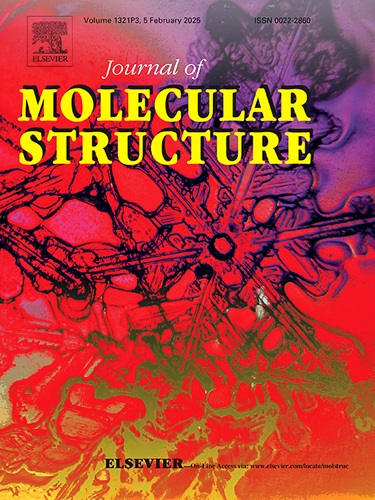Er/Yb共掺杂无铅卤化物钙钛矿Cs3Bi2Cl9的负热猝灭
IF 4
2区 化学
Q2 CHEMISTRY, PHYSICAL
引用次数: 0
摘要
制备了镧系(Er, Yb)掺杂的无铅卤化物钙钛矿(Cs3Bi2Cl9),其结晶为具有Pnma空间基的正交结构。该材料具有直接带隙(3.06 eV)和间接带隙(2.96 eV)。利用DFT理论计算还预测了Г位置的直接带隙(3.12 eV)和Г点到Г和Z点之间的低空间接带隙(3.08 eV),与实验观测值接近。优化后的Er/Yb: Cs3Bi2Cl9表现出强烈的上转换(UC)发射(λexc= 980 nm),表现出不寻常的负热猝灭效应,其中红色和绿色发射强度随温度升高而增加。这种效应是由于晶格的负热膨胀(NTE)和加热后样品中的水分的去除,从敏化剂Yb3+离子到激活剂Er3+离子的有效能量转移。这种独特的光学特性已用于使用荧光强度比方法的光学温度传感应用。Er/Yb: Cs3Bi2Cl9的绝对和相对温度灵敏度分别为1.07% K−1和0.98% K−1,相当好。这项工作为在高温下使用无铅卤化物钙钛矿设计光学温度传感器和探索更多显示NTE的卤化物提供了新的见解。本文章由计算机程序翻译,如有差异,请以英文原文为准。
Negative thermal quenching in Er/Yb codoped lead-free halide perovskite Cs3Bi2Cl9
Lanthanide (Er, Yb) doped lead-free halide perovskites (Cs3Bi2Cl9) have been developed, which crystallise into an orthorhombic structure with a Pnma space group. The material shows both direct (3.06 eV) and indirect (2.96 eV) bandgap. Theoretical calculation using DFT also predicts a direct bandgap at the Г position (3.12 eV) and a low-lying indirect bandgap from the Г point to a point between Г and Z point (3.08 eV), which are in close match with the experimentally observed values. The optimised Er/Yb: Cs3Bi2Cl9 demonstrated an intense upconversion (UC) emission (λexc= 980 nm), which shows an unusual negative thermal quenching effect, where the intensities of both the red and the green emissions increased with temperature. This effect is attributed to the efficient energy transfer from the sensitiser Yb3+ ions to the activator Er3+ ions due to the negative thermal expansion (NTE) of the lattice and the removal of moisture from the sample after heating. This unique optical feature has been used for optical temperature sensing applications using the fluorescence intensity ratio method. The observed absolute and relative temperature sensitivities of Er/Yb: Cs3Bi2Cl9 are 1.07 % K−1 and 0.98 % K−1, respectively, which is reasonably good. This work provides new insights for designing optical temperature sensors using lead-free halide perovskites at high temperatures and exploration of more halides showing NTE.
求助全文
通过发布文献求助,成功后即可免费获取论文全文。
去求助
来源期刊

Journal of Molecular Structure
化学-物理化学
CiteScore
7.10
自引率
15.80%
发文量
2384
审稿时长
45 days
期刊介绍:
The Journal of Molecular Structure is dedicated to the publication of full-length articles and review papers, providing important new structural information on all types of chemical species including:
• Stable and unstable molecules in all types of environments (vapour, molecular beam, liquid, solution, liquid crystal, solid state, matrix-isolated, surface-absorbed etc.)
• Chemical intermediates
• Molecules in excited states
• Biological molecules
• Polymers.
The methods used may include any combination of spectroscopic and non-spectroscopic techniques, for example:
• Infrared spectroscopy (mid, far, near)
• Raman spectroscopy and non-linear Raman methods (CARS, etc.)
• Electronic absorption spectroscopy
• Optical rotatory dispersion and circular dichroism
• Fluorescence and phosphorescence techniques
• Electron spectroscopies (PES, XPS), EXAFS, etc.
• Microwave spectroscopy
• Electron diffraction
• NMR and ESR spectroscopies
• Mössbauer spectroscopy
• X-ray crystallography
• Charge Density Analyses
• Computational Studies (supplementing experimental methods)
We encourage publications combining theoretical and experimental approaches. The structural insights gained by the studies should be correlated with the properties, activity and/ or reactivity of the molecule under investigation and the relevance of this molecule and its implications should be discussed.
 求助内容:
求助内容: 应助结果提醒方式:
应助结果提醒方式:


